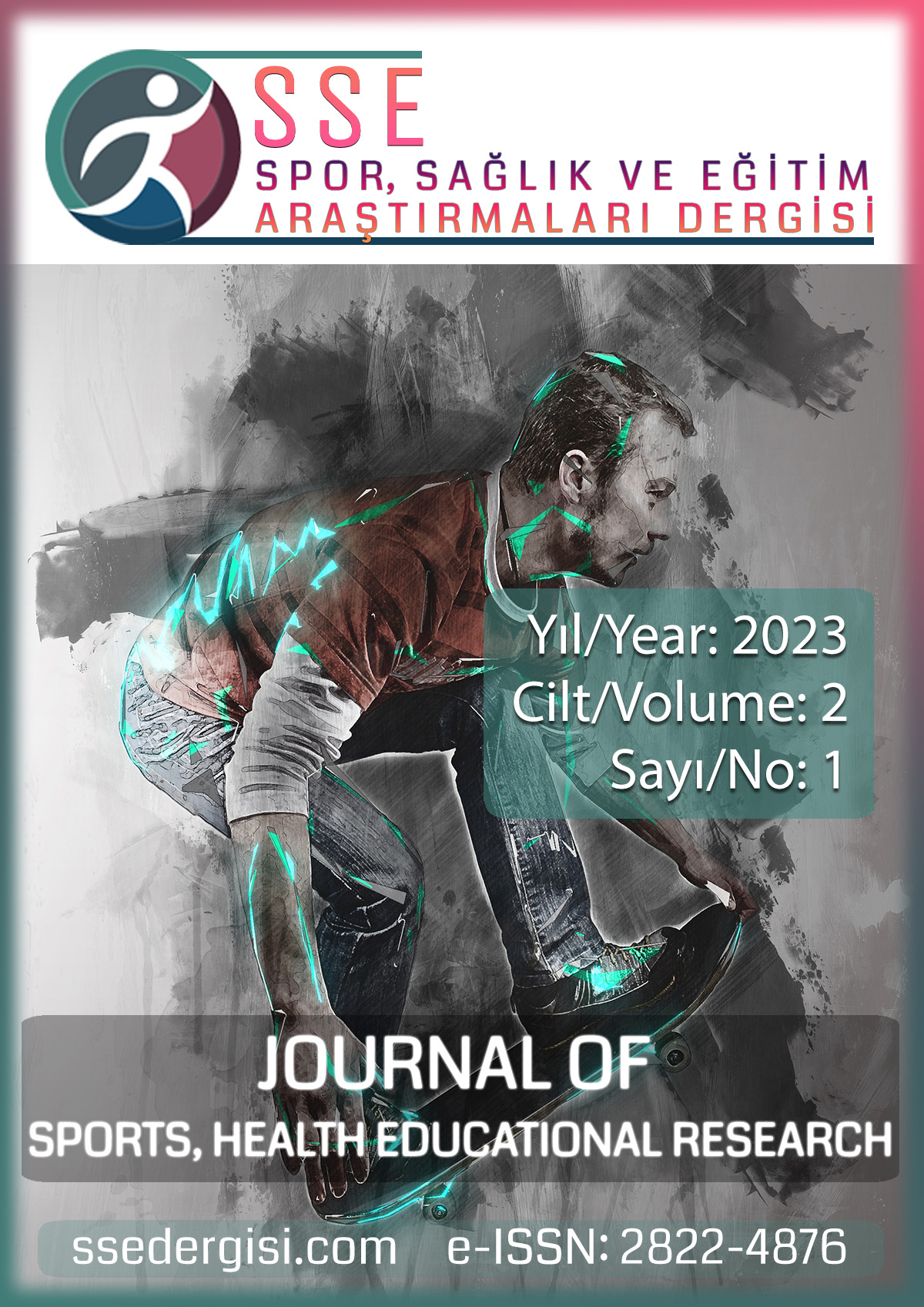Examination of Fitness Members Drive to be Muscular According to Demographic Characteristics
Keywords:
To be Muscle, Fitness, Use of Suplement, TrainingAbstract
The aim of this study; The aim of this study is to examine the urge to be muscular (KOD) according to demographic variables of male members who continue actively in recreational social life centers according to demographic variables. In the study, It was used to the urge to be muscular (KODÖ) developed by McCraery and Sasse (2000) and its Turkish transcription by Selvi and Bozo (2019). İn the this study was used to SPSS 22 program for analysis of the research, and in paired groups used independent sample t-test and in groups of more one-way anova. In our study, it was found that there was a significant difference in age, job group, and education level groups in the sub-dimension of use of reinforcements for muscularity; A significant difference was found in training behaviors towards being muscular (KOYAD) according to the age variable (p<0.05). As a result; It is thought that the participants tend to use reinforcements to be muscular in attitudes and behaviors and their demographic status may be effective in the differentiation of these findings.
References
Ahrendt, D. M. (2001). Ergogenic aids: counseling the athlete. American Family Physician, 63(5), 913.
Aşçı H. (2014), Does Physical activity/Exercise make women good? International Gender and Sport Symposium, Abstract Book, Ankara.
Alpar, R. (2018), Uygulamalı İstatistikte Geçerlilik Güvenilirlik, Detay Yayıncılık
Ata, Z. D. (2021), Kaslı Olma Dürtüsünün Spora Gelme Sıklığı ve Yaş Grubu Açısından İncelenmesi, The Journal of Academic Social Science Yıl:9, Sayı: 123, s. 468-47
Baştuğ G, Akandere M, Yıldız H. (2011). Sedanter genç kadınlarda aerobik egzersizin vücut kompozisyonu ve kendini fiziksel tanımlama değerlerine etkisi. Spor ve Performans Araştırmaları Dergisi.;2: 22-27
Brady AO, Straight CR, Evans EM. (2014). Body composition, muscle capacity, and physical function in older adults: an integrated conceptual model. J Aging Phys Act 2014;22(3):441-52.
Calfee R, Fadale P. (2006). Popular ergogenic drugs and supplements in young athletes. Pediatrics. 2006 Mar;117(3): e577-89. doi: 10.1542/peds.2005-1429. PMID: 16510635.
Chaba, L., d’Arripe-Longueville, F., Lentillon-Kaestner, V., Scoffier-Mériaux, S. (2019). Drive for muscularity behaviors in male bodybuilders: a trans-contextual model of motivation. Journal of Eating Disorders, 7(44), 1-11
Eik-Nes, T.T., Calzo, J.P., Austin, S.B., Blashill, A.J., Murray, S.B. (2018). Prospective health associations of drive for muscularity in young adult males. Int J Eat Disord., 51, 1185–1193. Doi:10.1002/Eat.22943
García-Rodríguez, F. J., Gil-Soto, E., Ruiz-Rosa, I., Gutiérrez-Taño, D. (2017). Entrepreneurial potential in less innovative regions: the impact of social and cultural environment. European Journal of Management and Business Economics.
Selvi, K. ve Bozo, Ö. (2019). Kaslı Olma Dürtüsü Ölçeği’nin Türkçe uyarlaması: Geçerlik ve güvenirlik çalışması, Nesne Dergisi, 7(14), 68–82.
Karacan, S.,Çolakoğlu, F. F. (2003). Sedanter orta yaş bayanlar ile genç bayanlarda aerobik egzersizin vücut kompozisyonu ve kan lipidlerine etkisi. Spormetre Beden Eğitimi ve Spor Bilimleri Dergisi, 1(2), 83-88.
Litt, D. ve Dodge, T. (2008). A longitudinal investigation of the Drive for Muscularity Scale: Predicting use of performance enhancing substances and weightlifting among males. Body Image, 5(4), 346–351
McCabe, M. P. ve Ricciardelli, L. A. (2004). Body image dissatisfaction among males across the lifespan: a review of past literature. Journal of Psychosomatic Research, 56(6), 675–685
McCreary, D. R. ve Sasse, D. K. (2000). An exploration of the drive for muscularity in adolescent boys and girls. Journal of American College Health, 48, 297–304.
Mosley,2009, P. E. (2009). Bigorexia: Bodybuilding and muscle dysmorphia. European Eating Disorders Review, 17(3), 191-198.
Morrison LJ, Gizis F, Shorter B. (2004). Prevalent use of dietary supplements among people who exercise at a commercial gym. Int J Sport Nutr Exerc Metab. 2004;14(4):481-92.
Ojala K, Tynjälä J, Välimaa R, Villberg J, Kannas L. (2012). Overweight Adolescents’ Self-Perceived Weight and Weight Control Behaviour: HBSC Study in Finland 1994–2010 J Obes. 2012; 180176 (Published online 2012 May 28. doi: 10.1155/2012/180176).
Oliveira AJS, Miranda León MT, Guerra-Hernández E. (2008) Estudio estadístico del consumo de suplementos nutricionales y dietéticos en gimnasios.A LAN. 2008;58(3):221
Uluyol, F. M. (2020). Erkeklere Özgü Beden Tutum Ölçeği (EÖBTÖ)’nin Türkçe Formunun Geçerlik ve Güvenilirlik Çalışması. Nesne-Psikoloji Dergisi, 8(16), 31-42.
Penedo,F.J, Dahn,J,R.(2005). Exercise and well-being: a review of mental and physical health benefits associated with physical activity. Current Opinion in Psychiatry, 2005; 18(2): 189-193.
Richman EL. (2000). Shaffer DR. If you let me play sports: How might sport participation ınfluence the self-esteem of adolescent females? Psychology of Women Quarterly. 2000;24: 189-199.
Taşpınar, F., Seyyar, G. K., Kurt, G., Okur, E. Ö., Afşar, E., Saraçoğlu, İ.,Taşpınar, B. (2017). Üniversite Öğrencilerinde Vücut Kompozisyonu ile Fiziksel Aktivite, Denge ve Destekleyici Faktörler Arasındaki İlişki
Yarar, H., Fidan, M., Karahan-Yılmaz, S., Eskici, G., ve Saraç, O.E. (2022). Sporcularda kaslı olma dürtüsü ve besinsel ergojenik destek ürünleri kullanımının değerlendirilmesi. Spor Bilimleri Araştırmaları Dergisi, 7(1),162-173
Downloads
Published
How to Cite
Issue
Section
License
Copyright (c) 2023 Spor, Sağlık ve Eğitim Araştırmaları Dergisi

This work is licensed under a Creative Commons Attribution-NonCommercial 4.0 International License.


